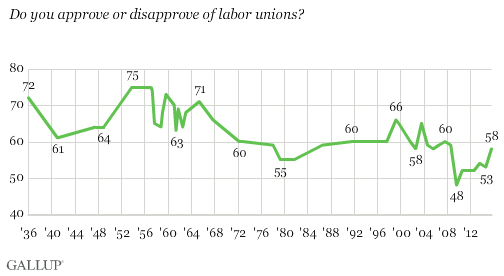Recent polling from the Gallup organization shows support for labor unions on the rise. Women and millennials are particularly pro-union.

Recent polling from the Gallup organization shows support for labor unions on the rise. Around the time of the economic crash of 2007-08, public opinion about unions reached an all-time low, with just a 48 percent approval rate in 2009, perhaps fueled by persistent demonization of organized labor by right-wing politicians and the organizations that back them. But since then, Gallup reported in August 2015 that public approval of organized labor climbed by 10 points to 58 percent.
Predictably, the Gallup survey found support for unions strongest among Democrats, and weakest in the South. More novel is the breakdown along gender lines: Women approve of unions in much higher numbers than men, with 63 percent of women reporting their support, compared with 52 percent of men. Likewise, greater numbers of women reported wanting to see unions gain more influence in the political process, 41 percent, compared with the 33 percent of men who said they did.
A brief issued this month by the White House Council of Economic Advisers may offer a key to that finding. Union membership, the authors write, has “become more representative of the population, with the share of members who are female or college-educated rising quickly.” The brief goes on to explain, “These demographic shifts have been driven in part by the rise of public-sector unions, since public-sector union members are more likely to be female and college-educated than their private-sector counterparts.”
A strong majority of young people, Gallup found, view organized labor favorably, with 66 percent of those between the ages of 18 and 34 expressing support for unions, compared with 53 percent of those in the 35- to 54-year-old age group. Among those in the younger age group, a plurality wanted to see labor’s influence grow in the political process.
In its brief, titled “Worker Voice in a Time of Rising Inequality,” the Council of Economic Advisers notes a positive spillover effect on the children of union members, or even those who grow up in geographic areas with higher union density, citing research that shows higher earnings by those who grow up in union households, or in union-dense areas. But that alone can’t account for the impressive support for organized labor by millennials, which is likely also influenced by the growth of the so-called “gig economy,” and unregulated work schedules, as well as the fact that wages, according to Amy Traub, senior policy analyst at Demos, “are frozen.”
All Workers Benefit
In its brief, the Council of Economic Advisers notes that unions improve standards for all workers, a fact to which the public may be catching up as the gulf widens between the haves and have-nots. “Unions today represent a very different workforce – one less male, more concentrated in the Northeast, and more educated – than they did at their peak in the 1950s,” write the authors of the White House brief. “For these workers, unions provide an important channel for worker voice and have historically afforded benefits for both union members and other workers.”

